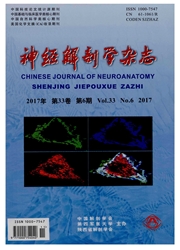

 中文摘要:
中文摘要:
胶质细胞系源性神经营养因子(GDNF)可以通过跨膜的酪氨酸蛋白激酶受体RET激活细胞内两条信号通路,即磷脂酰肌醇3激酶(P13K)僻号通路和Ras/Raf/MEK/Erk信号通路。为探讨往GDNF促进中腑多巴胺(DA)能神经细胞存活和分化过程中,上述两条信号通路所发挥的作用,本研究住建立GDNF促进中腩DA能神经细胞存活和分化的细胞培养模型的基础上,以P13K信号通路中P13K的特异性抑制利Wortmannin和Ras/Raf/MEK/Erk信号通路中MEK的特异性抑制剂PD98059分别阻断上述两条信号通路;结合免疫细胞化学染色技术,以DA合成的限速酶酪氨酸羟化酶(TH)的染色情况为指标来观察上述两条信号通路对DA能神经细胞存活和分化的影响。结果显示,Wortmannin可以阻断GDNF促进TH阳性神经细胞数目及其突起增加的作用;而PD98059对GDNF的生物学效应没有影响。结果提示P13K而非Ras/Raf/MEK/Erk信号通路介导了GDNF对中脑DA能神经细胞存活和分化的促进作用。
 英文摘要:
英文摘要:
It is known that through binding to the tyrosine kinase receptor RET, the glial cell line-derived neurotrophie factor (GDNF) activates two intracellular signaling pathways: the phosphatidylinositol 3 kinase (P13K) pathway and the Ras/Raf/MEK/Erk pathway. The possible roles of these two pathways for GDNF to promote the survival and differentiation of DA neurons were explored on the cultured cells derived from the ventral mesencephalon of the 19-day-old embryonic mice in the present study. The specific inhibitors of the P13K pathway (wortmannin) and Ras/Raf/MEK/Erk pathway (PD98059) were used to block the pathways, respectively, lmmunocytochemical staining of tyrosine hydroxylase (TH) was used to visualize the DA neurons under light microscope. The results show that wortmannin blocks the promoting effect of GDNF on the survival and differentiation of DA neurons, suggesting that it is the P13K pathway, rather than the Ras/ Raf/MEK/Erk pathway, that takes the main part in the process.
 同期刊论文项目
同期刊论文项目
 同项目期刊论文
同项目期刊论文
 期刊信息
期刊信息
